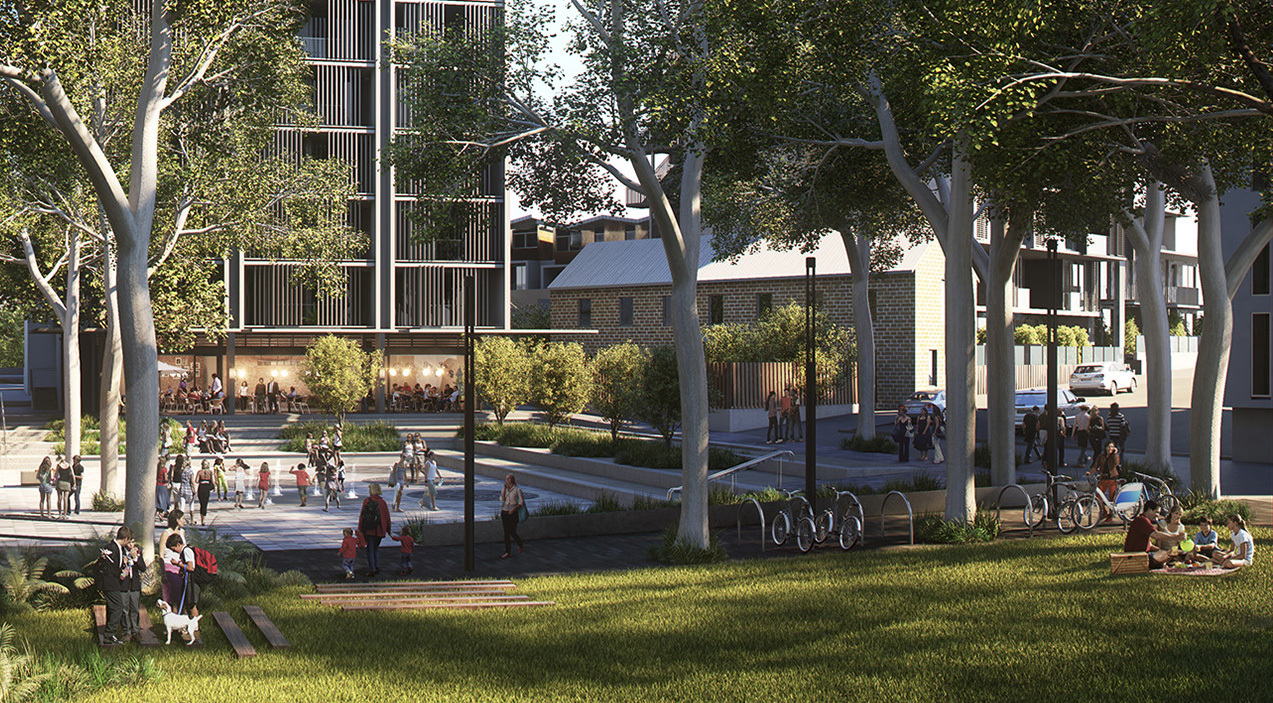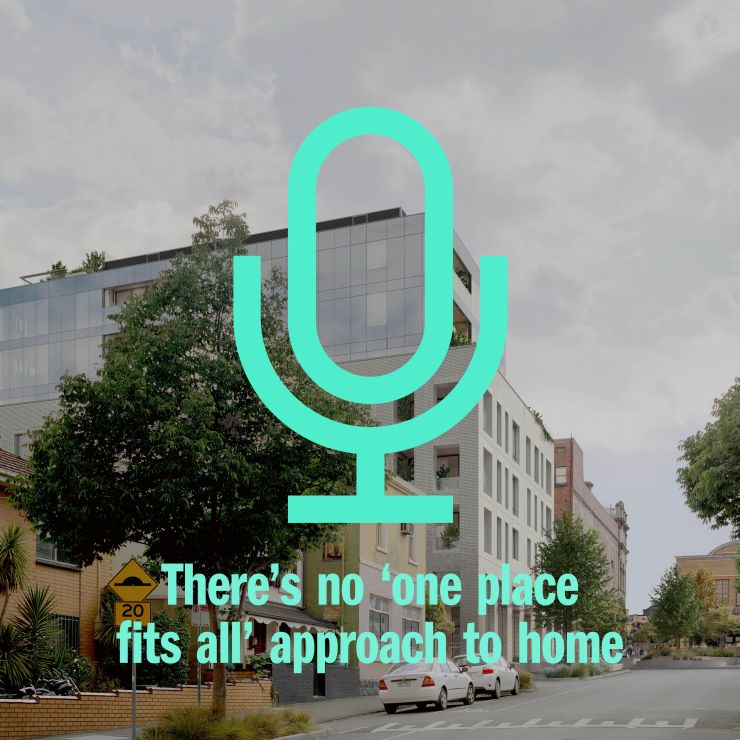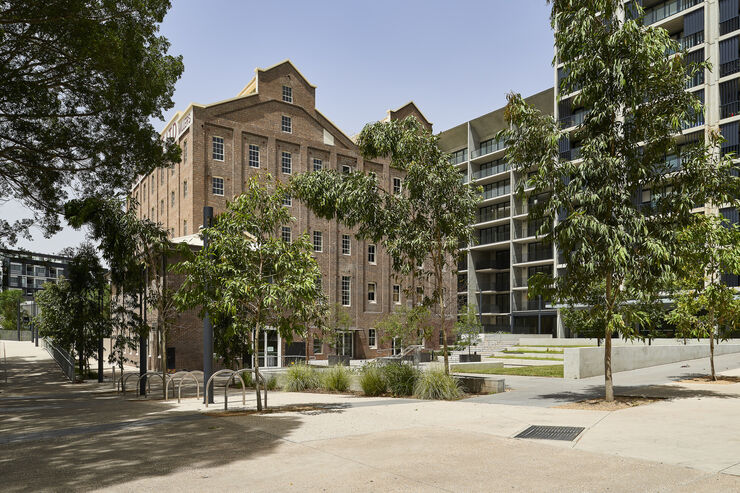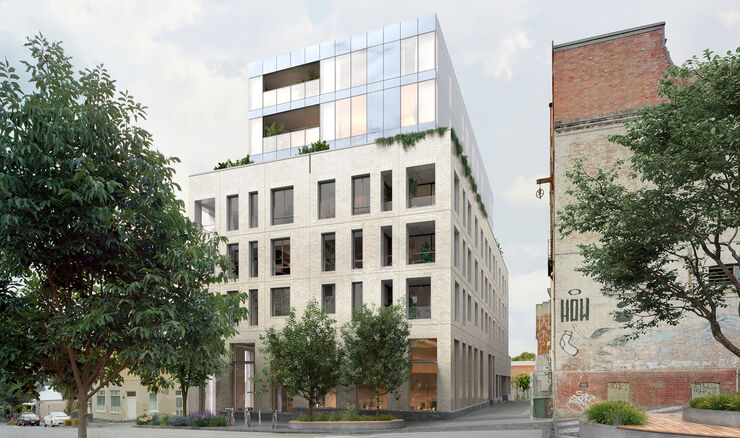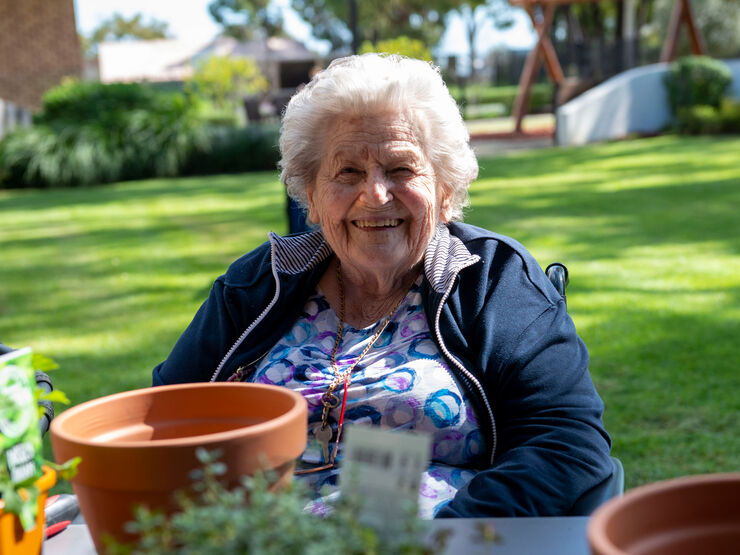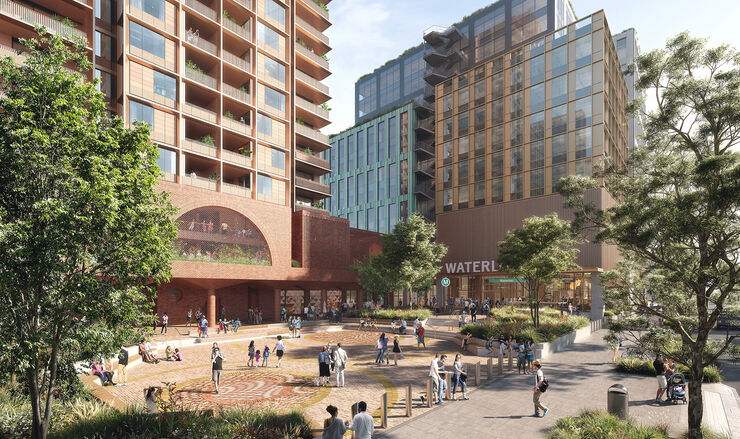Transcript
Jeremy Schluter introduces episode:
From global design practise Hassell, this is Hassell Talks, a podcast series looking at a changing and complex world and the opportunities for design to create a better place for everyone.
It’s a series that is unashamedly optimistic about designing for a beautiful, inclusive, and resilient future. I’m Jeremy Schluter. I’m an architect and I co-lead the residential sector at Hassell, which means I spend a lot of time thinking about how we live and how we can all live better. And our guest today is Fiona Dunster, Senior Investment Director within the property team at AustralianSuper.
And I acknowledge the Wurundjeri Woiwurrung people of the Kulin nation, their elders past and present as traditional owners of the lands where I live, work and play and pay my respects to the First Nations people across Australia as custodians of these lands.
With a housing crisis that’s starting to bite, we’re taking a closer look at just how the residential sector is responding, the role of design in ensuring projects can still succeed despite the new challenges they increasingly face, and some alternatives that will serve communities, economies and our world in making places people love.
In our last episode, we heard from Michael McCormack, co-founder of the Milieu Property Group, about the socially aware design-savvy market that’s emerging, driving positive change in our cities through a new type of residential project with quality, wellbeing, location, sustainability, and amenity at the top of the brief. For this episode, I wanted to take a closer look at some emerging housing models where residential design and housing affordability meet at scale. When we talk about creating affordable housing, I think many people imagine this to mean what we call council housing, the post-war towers and apartment blocks that as a model don’t have wellbeing as a top priority and aren’t particularly welcoming or safe. The British and other parts of Europe have an established legacy of public council and affordable housing, so have over time improved these models. In Australia, very little public housing has been built since the post-war era, and so governments are looking to the private sector to step in and partner in making up the shortfall. Programmes such as the New South Wales Communities Plus precincts and Victoria’s Big Build to name a few.
It is this context that has seen organisations, big investors like superannuation funds, identify the opportunity to get involved, tapping the demographic shifts of demand in the market. Their involvement supports economic and community goals including sustainability and generates a return on investment through new affordable housing projects. And my guest today, Fiona, is going to tell us all about it.
Part of her role as a property investment director is to reposition the fund, Australia’s largest superannuation fund, to become a hands-on very active investor in the spaces super funds haven’t traditionally played in. They’re taking on things like planning and construction risk. They’re bringing not just money but the smarts to the table as well. Interestingly, their involvement taking a longer term view to investment returns has also supported an increased awareness of ESG and sustainable development, something that not only the market is looking for more and more since the pandemic, but also just makes good sense from a long-term investment perspective with climate risks only growing.
And so I wanted to ask Fiona about one of their big projects in the UK, Canada Water, as well as the potential Australian Super saw in a new affordable housing model targeting Australia’s first home buyers, known as Build to Rent to Own with a group called Assemble. Build to Rent to Own is an idea that creates an alternative pathway to home ownership, enabling people to rent securely for five years in a home they can make their own. They can paint it, hang pictures up and so on, all while saving their deposit with the option to buy their home for a pre-agreed price at the end of the lease period. And the Assemble model, as you’ll hear, is proving very successful with three locations and 450 dwellings so far, all underpinned by the belief that every Australian deserves access to an affordable, well-designed home and everyone deserves a community to come home to.
Fiona Dunster begins speaking:
There’s an awful lot of discussion at the moment in the market around build-to-rent and how it’s all about establishing a community on a TOPSIS basis and that is absolutely fundamental for Build to Rent to Own. From ours and Assemble’s perspective, the most critical thing about the Assemble product is ultimately that we want people who come to rent to stay and buy. The stickiness of the tenants is absolutely the key. So for us it’s about sense of community and that is built through things like specific spaces that encourage interaction.
So Assemble’s classic offer is that there’s communal laundry so you can bump into people when you’re down there sorting your washing or putting a load of washing on. There’s a dog wash. And for some of our newer ones, in fact TSK is going to have a dog walk area up on the roof, which is pretty cool. There’s a thing called the Assemble room and that’s where residents can do yoga, they can work from there if they want to, they can run their book club. It has a kitchen facility so they can book it out for a dinner party if they want to hold a dinner party there. So really thoughtful functional spaces and facilities. And probably my favourite one is the thing called the tool library.
Jeremy Schluter: Oh, yes.
Fiona Dunster continues: That’s not just a space, but it’s actually fully kitted out so it can have an iron or a drill or a level.
Jeremy Schluter asks: So you can still make stuff?
Fiona Dunster answers: Yes, you can still make stuff down there. There’s a bench, there’s a whole all range of things that in your everyday life now and then you need. But let’s be honest, in lots of apartments, you never have enough room to actually be able to have them all stored there. So it gives you this fantastic facility that you can access and it’s all run off the Assemble platform. People can just book it, they can book a space or they can book a hammer or book a kettle and it all works off this platform. The platform also organises get-togethers, informal sort of social interaction.
So all these things create these layers in engagement and value that we think goes well beyond just the fact that these sites are really well-located.
The people who buy into Assemble are buying in because they’re looking to have a real sense of place and have a real home. They tend to not be transient because if they were, they’d just go and rent something, but they’re renting with the objective of ultimately owning. And with that comes a really much richer investment both of their own time into their neighbours, but also into their facilities that they really want to use and where they find value.
So for us, we think that’s the real differentiator for the Build to Rent to Own because there’s fantastic build-to-rent that’s coming online, but we think they don’t have quite the same richness.
And another great example is that the Macaulay Road ground floor area is an operating café by day and it’s quite a little jumping spot at the moment. It’s doing really well, but at nighttime it becomes the residence area. And no, they can’t access the bar, but they can certainly access all the other areas so that they hold a movie night down there, they get together and it can be an additional breakout area, lounge area. We’ve often got residents down there that are just working late at night using it as an informal workspace. And we are finding that’s- (stops)
Jeremy Schluter interjects:
Rather than working in their living room.
Fiona Dunster responds:
Yeah, or even in the Assemble space, which is actually up top on the roof, which is really cool. So it’s giving our people a variety and a diversity of spaces that they can break out into in effect well beyond their home, but they’re within their home. And we think that’s just hugely important and really valuable.
Jeremy Schluter responds:
And it will be great to see some of the data come back in as the residents do start to move in.
Fiona Dunster says:
Well, that’s right. And for us the key is to watch that they stay. And one of the things the Assemble model does is it actually offers financial coaching to our residents, which is seen as a real benefit cause a lot of those people haven’t had the benefit before of having someone who can work with them, who looks at their lifestyle and looks at their costs and actually helps them see a pathway to actually being able to own, which is really important.
There’s no doubt that the design and the careful consideration around offering a really truly sustainable way to live is key for our target market. The people who want to come and live at Assemble absolutely want to understand how they’re going to be able to live there in a way that is going to enable them to reduce the energy usage to be really actively involved in living in spaces that really prioritise the cost, natural materials, ventilation, low energy, obviously proximity to public transport, green spaces within, all those obviously again lend themselves to sustainability. So all the Assemble products will have to be within walkable distance of not just public transport but also external green spaces.
Jeremy Schluter asks:
Can you tell us a bit about why Super was interested in that particular model?
Fiona Dunster answers:
Yeah, look, we did quite a bit of investigation into a number of developers and groups that were looking at trying to address housing. And I guess for us, the Assemble Build to Rent to Own model is really providing an opportunity for a pathway to home ownership that wasn’t being achieved or really offered by any other group. So the AustralianSuper board right at the top of the tree has a Supporting Australia Economy initiative, which is a really important initiative of our board. And we really saw Assemble’s Build to Rent to Own model as a way to support that initiative.
So for us, Build to Rent to Own was a really attractive concept. It gave us reasonable return, it gave us a chance to enter the BTF market locally. So we’ve already got some multifamily in the States and we’ve had a bigger portfolio of that previously, but it gave us a chance to enter the market here. We were really attracted by the ability to scale the pipeline. So not only have we invested into investments within Assemble, we’ve also invested in the actual platform. And the last thing really for us was because Assemble was Melbourne-based, it gave us a chance to really get in to understand this market and this type of investment in our local market, which for us was really important as well.
Jeremy Schluter asks:
And Build to Rent to Own aren’t the only options or ways of approaching housing and achieving some of those great things that you are talking about for AussieSuper, for your investors, for your board and so on. Can you introduce us to the vision behind Canada Water?
Fiona Dunster answers
Yeah, so Canada Water, just for those who don’t know, it’s actually a 53-acre land region opportunity in the heart of London. So people might know that we are the majority owner of King’s Cross, which we’ve been quietly involved in developing over the last 20 or so years. So Canada Water is our newest baby.
So we invested into Canada Water with British Land earlier in this year as a 50-50 joint venture. And this is a 10-year build out project for us. So it’s got a lot of similar fundamentals like King’s Cross in terms of placemaking will be fundamental. It is actually greener. It’s already got, oh gosh, something like, I don’t know, 50% or 12, no, 12 acres of it is already parkland established. So it’s a different type of proposition, but it will be mixed-use. So it will have some office, we’ll have some life sciences, some residential, and there’s a whole mix of types of homes.
So I think there’s over 2,600 homes are being built at Canada Water over the period and something like 30, I think it’s 33% of them will be social or what they call over their intermediate homes, which is affordable. So a huge housing investment as part of that. But the housing will be different there. And look, it doesn’t mean that Build to Rent to Own conceptually might not be part of it. I mean it might be, this is a very new concept, obviously developed by Australia and conceived by Assemble.
But look, it might end up being part of that, but it’s certainly, over there with Canada Water, it’s a combination of more what we would call affordable in the Australian market in that it’s really targeting the essential worker type segment. But then there is also a social housing element which is being supported by the community housing providers over there as well and the government. So it will be a real blend of housing. There’ll also be townhouses apartment trying to meet the needs of more socioeconomic groups that can afford to pay high prices and be closer to things like certain amenities that they might value. So it will be a real mix, so it’ll be fantastic. Yeah.
Jeremy Schluter asks:
One of the statements we’ve seen about Canada Water is that it will set new standards for what’s possible in urban living, working and regeneration when entire precincts and communities are designed around ESG, the ESG approach, what do you anticipate the outcomes might be?
Fiona Dunster answers:
The reality is we want our residents and our office workers and our visitors all to come and feel really attached and connected to the environment. So that will come through in a range of things, not just from a whole lot of beautiful parklands and connection to the river, physical connection, but it’ll come through in the design of our buildings. So we are looking at, and it’s interesting with the UK, it’s obviously different climate to here, but how can we look at using natural ventilation? How can we look at lighting systems and things which are going to support being part of and occupying environments that make you feel good.
Being the scale it is, Canada Water has the opportunity to be more than just a few green buildings. It has a chance to actually be a truly green precinct. And for us, that’s one of the benefits again of scale. We can really invest into those broader initiatives which you wouldn’t possibly otherwise be able to justify from just a pure investment perspective. From a design perspective and a buildings perspective, there’s no doubt people are thinking more about the value of carefully planning and selecting materials, thinking about glazing, thinking about openings, thinking about things that will ultimately have impacts on operating costs and just health and wellbeing. And I think we are thinking about it at a more sophisticated level now than we were before the pandemic for sure.
Jeremy Schluter asks:
And I’m certainly hearing more residential developers than ever before actually talking about sustainability. I feel like the residential sector hasn’t always been the leader that it could be within the sustainability and resilience space. And it’s refreshing to see that conversation happening more and more within the residential market.
Fiona Dunster answers:
Yeah, I think that’s right. But again, of course we’re all being driven by the demand of the communities that we are working in. So it again is a real momentum building now that is a lot more than just talking about sustainability because they think it’s the right thing to do. There’s a really genuine understanding now of the imperative of it, which is great. It’s a shame it took a pandemic maybe to give it the nudge it needed. But anyway, we’re there.
Jeremy Schluter asks:
And it seems to be, you mentioned before sticky spaces and the way that you are talking about Canada Water seems to be a similar almost mentality to how the commercial development sector has been operating. The acknowledgement that to retain tenants, you have to build these things, you have to create these types of places and spaces, and then by retaining the tenants longer term, then they have a happier, healthier working life. It seems more and more now rather than simply selling off the plan, the residential market is kind of catching up to that approach.
Fiona Dunster answers:
Yeah, I think that’s right. But I think we’ve come a long way too just in terms of the way we view buildings and we view spaces within which we all do interact and work and play. And I think it’ll be a pretty poor investment decision these days to look at anything in isolation. So for us it really is about creating spaces and places that people really do want to invest not just their money into to be a tenant or to live in, but to actually invest their heart and soul into and becomes their place.
And to your term before, the sticky tenants, the sticky residents, the sticky visitors, the people who keep coming back, that’s what creates the thing that that’s unique about a place and the thing that makes people want to return and that’s where the value is. So for AustralianSuper, ultimately we’re an investor and we have to not just create great places that people want to come to, but we have to create great places that people want to stay at or return to.
And so for us, it’s not even a question of “Should we?” We have to. We have to come up with ways of creating sustainable communities which are sustainable in every way. And for us, sustainability means being accessible physically, financially, to all walks of life and all manner of people. And that means that you have to create wonderful, wonderful places at the ground plane that support everything that’s happening above it. So I think for us it’s just not even a no-brainer. Otherwise, there’d be absolutely value in investing because it would have no value into the future. And for us as long-term investors, it’s all about building and creating spaces for the future.
Jeremy Schluter asks:
Well, and the beautiful thing is that creating those communities and those places and spaces that people want to be at and want to stay at and want to return to, presumably lowers your risk and makes better financial sense. So you’re doing good things in order to support your ability to do more good things.
Fiona Dunster answers:
It does, but at the end of the day, as you know, it’s about being very robust in how you assess those risks and how you also assess the opportunity for AustralianSuper. This is where the partner is so critical, so understanding their capabilities, understanding their track record, being confident that we’ve got the right people on the ground who know the right questions, who understand what really is risk and opportunity associated with creating new places. It’s a very different proposition to buy something that’s already humming along.
This goes back again to the criticality of building the right people within AustralianSuper and also surrounding ourselves with the right partners that we really see ourselves being able to confidently and appropriately assess those risks and make those decisions. But certainly with things like King’s Cross, we’ve learned a huge amount and we’re now leveraging a lot of that knowledge into our new at-scale precincts moving forward. And we’re certainly hoping to do a number of these.
Canada Water’s the latest one, and as I said, we’ve got a great partner in British Land and we feel really confident and comfortable that we’ve assessed what the risks might be for Canada Water, but obviously the opportunities and we feel that we’ll be able to deliver on that and deliver something that’s great, not just for our members, but for the community more broadly within London.
So we’ll look for these all around the world, to be honest with you now, but one of the most important things up front will be who will be doing it with us, and that’s a big part of our risk assessment.
Jeremy Schluter asks:
And the impact of people and communities to the future of housing, and I know the pandemic is something in the past now we’re still dealing with it’s still around, but that has changed as well. I think the art of purposefully and intentionally creating communities with people potentially before the pandemic has been forgotten a little over the decades to a point where it’s common for people not to know their neighbours. How do you think the pandemic has changed how we view our communities and assess the strength of neighbourhoods and how is that having an impact in the residential sector?
Fiona Dunster responds:
Yeah, look, I think you’ve said it beautifully actually. I think that’s right. I think the pandemic has really reminded us all about what’s so important and the importance of people around us, our families and our friends, and the people we work with.
But look, I think it’s playing to the Assemble proposition to be honest, in terms of housing styles and housing formats and housing models. I think we’re going to see more and more around the value proposition of residential being not just your house, not just the space that you live in and you occupy, but what else comes with it and how does that support that much, much stronger sense of community that I think we’re all looking for.
Jeremy Schluter comments:
And I think one of the positive developments in the housing market over the last probably five years is that it’s no longer a one size fits all approach to providing housing for Australia, for anywhere around the world. There are new little innovations and models and distortions in the housing market, which are providing more choice and more different alternatives for people to live, how they want to live, where they want to live. So I wonder if, yeah, as you say, there are some silver linings, but it’s interesting as well that there’s no silver bullet.
Fiona Dunster responds:
No, I think there’s not. I mean, at the end of the day, the most basic is that we have a whole group of Australians who fundamentally don’t have the earning capacity to rent and/or buy in a lot of Australia’s bigger cities in an environment where housing prices continue to either increase or have stabilised and they’re still high, and we’ve got costs only continue to increase and wage growth minimal, if at all. It’s hard to see how we’re going to actually be able to house a lot of these people without major intervention.
I think there’s such a supply shortage in Australia. It’s just compounding all these other problems. If we didn’t have supply shortage of housing stock, it would have obviously an impact on house pricing and even if we weren’t building anything, would be in a much better situation. But the reality is we’ve got a massive housing shortage and with immigration starting to increase again, which is a great thing for Australia, then obviously those pressures only compound.
I don’t think it’s going to be a quick or easy solution. And the government’s recent Accord announcement, which obviously we’re supportive of, and we are working closely with the other superannuation funds, AustralianSuper fund family, to work out how we can potentially participate in the Accord housing accord in a meaningful way. It’s great to see that the government has put this initiative forward. There has to be some things, some progress made on things like planning, for example, just to increase the speed of being able to open up land or get approvals through to actually enable the housing to be delivered, land supply.
As to your point, there are lots of innovative ways that maybe we can look at the government participating with housing providers, whether it’s super funds or others, which might involve long-term, 100-year leases on land, for example. It’s just an idea I’m just thinking about, which enables the cost perhaps of delivering that housing to be significantly reduced for the end renter or buyer.
So I think we are in a time of complexity and it’s really unknown with what’s going on economically and politically around the world, and certainly I think it’s also a great chance for innovation. Yeah, looking forward to seeing how we’re going to solve this.
Music fades in.
Jeremy Schluter now summarises:
I left my chat with Fiona feeling so optimistic. For too long, the residential market has been profit-driven based on short-term gains, leaving the residents in our cities as an afterthought. This has left us with a legacy of small, questionable quality unaffordable apartments that are not really future-proofed for the climate crisis we’re facing.
With larger players like Australian Super, getting behind new alternative models such as Build to Rent to Own, we are finally seeing those forward-thinking innovations to develop in quality housing with humanity. Apartments that are well-designed with people and the city in mind to present as a real alternative to the suburban quarter-acre block. Dwellings that are fundamentally sustainable rather than just greenwashed, that also support social inclusion and improved housing access backed by a private sector who see the value in long-term return opportunity.
These are not new ideas. In fact, they were fundamental to the Flour Mill of Summer Hill precinct we designed for developer EG, completed in 2019 before the pandemic. The project master plan gave over 40% of the site to a network of quality public spaces and the relifeing of some beautiful heritage buildings. These community investments have been supported by a curated programme of markets, playgroups, dog walkers and more, creating a strong sense of belonging and human connection. Homes at Flour Mill of Summer Hill are very much in high demand with a community that thrived during the pandemic. An embedded future-proof design and quality outcome has made it a place people love to be.
I think the future looks bright and I remain optimistic. With the right conversations between both public and private across the industry and designers, of course, we can unlock innovation and creativity and ultimately quality housing for people in strong communities and cities.
Thank you to Fiona and Australian Super for her time and enthusiasm, and thanks to you, our listeners. We know you’re as passionate about the role design plays in creating a beautiful, resilient and inclusive future as we are.
I’m Jeremy Schluter. You’ve been listening to an episode of Hassell Talks. This episode was produced by Prue Vincent.
Music fades
